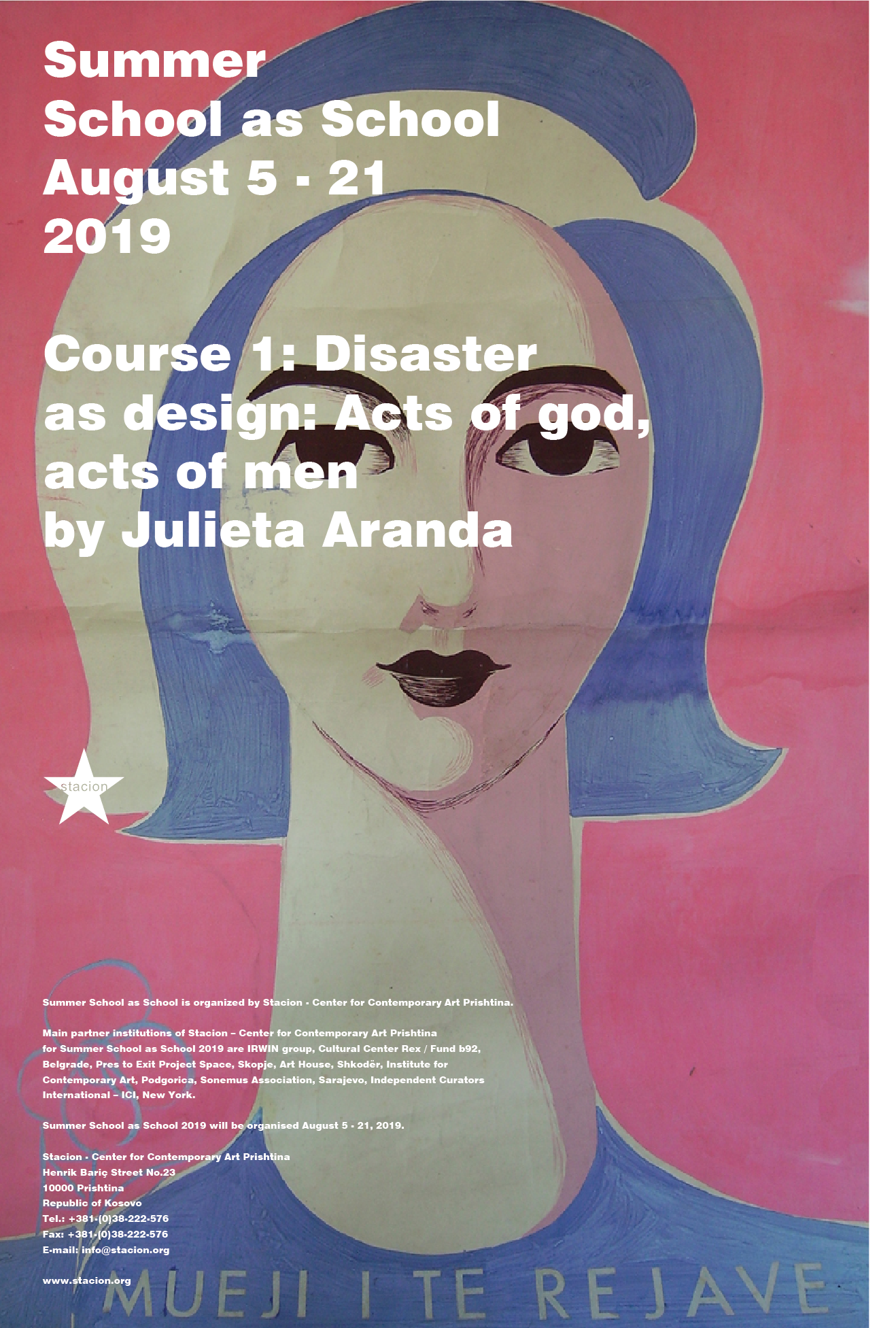
Course 1: Disaster as Design: Acts of god, Acts of men
by Julieta Aranda
5 – 10 August, 2019
Course Description
Maybe the first sign of this was the tornado chasers. Back in the 1990s, when I first moved to NY, there were tornado chaser specials on the weather channel, and I would sometimes sit through them: 2 guys in a pickup truck, providing a live feed of their trying to get as close as possible to a tornado. There was actually enough of an audience for this kind of material, so that late night weather channel special, in the 2000s, has been spun into quite a few movies…. It seems that there is an appetite for disaster everywhere, and it just keeps getting bigger.
When we look at disasters: volcano eruptions, landslides, sinkholes, forces of nature that swallow entire villages, oil spills, exploding whales, plastic-bloated whales… what is it that holds our fascination? Perhaps it is because the destruction of the natural world can occupy us enough, somewhat objectively, so that we don’t have to look into the current state of our subjectivity: the drama is elsewhere.
However, if we take our attention away from the spectacle of dystopia, and place it for a second on our conditions as subjects, there are equal causes to worry. It is not just the natural world that is in tatters, but the constitution of our internal worlds is not doing much better.
Without a strong sense of ourselves as subjects (what we call a collective subjectivity) we become weak units, easy pray for the wellness industry, and for opportunistic movements that try to replace the backbone of a collective subjectivity with the idea of nationalism and far-right political propositions.
So, how do we take back the production of our own conditions as subjects, at a moment when the definitions of what the world is and what it is to be human seem to be up for grabs?
This, and a bit more, is what we will be doing in this course. The course is not going to be focused on art directly, but on the relationship between art, speculation and dystopia.
It will be an exploration of disaster and design, as well as the notion of unexpected effects (what we can call excess outcome). You can expect to read a lot, to talk a lot, and to work in teams towards the production of speculative projects, part fictional narratives, part art-making.
Biography
Julieta Aranda is co-director of e-flux and a frequent instructor for the master seminar “Art & Science” at the Art Institute in Basel, Switzerland. She holds a B.F.A. in filmmaking from the School of Visual Arts (New York) and an M.F.A. from Columbia University (New York). Her explorations span installation, video and print media, with a special interest in the creation and manipulation of artistic exchange and the subversion of traditional notions of commerce through making art. Aranda’s installations and temporary projects are intensely site-specific and often examine social interactions and the role that the circulation of objects plays in cycles of production and consumption.
Julieta Aranda‘s work has been exhibited internationally, in venues such as the Der Tank, Basel (2016); 56th Venice Biennale (2015); the Guggenheim Museum, New York (2015, 2009); Kunsthalle Fridericianum, Kassel (2015); the 8th Berlin Biennale (2014); Berardo Museum, Lisbon (2014); Witte de With, Rotterdam (2013, 2010); Museo d’Arte Contemporanea Villa Croce, Genova (2013); MACRO Roma (2012); Documenta13 (2012); N.B.K. (2012); the Gwangju Biennial (2012); the 54th Venice Biennale (2011); the Istanbul Biennial (2011); Portikus, Frankfurt (2011); New Museum, New York (2010); Kunstverein Arnsberg (2010); MOCA Miami (2009), Museum of Contemporary Art, Chicago (2007) and the 2nd Moscow Biennial (2007).
Participation
10 participants will be selected to participate in this course. Eligible participants must read the Terms, fill out the application form, upload the required documents and submit the application form. Incomplete applications will not be considered.
Scholarships are available for participants from Kosovo.
A limited number of scholarships, that cover the participation fee, are available for international participants.